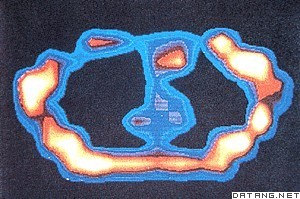1) Susceptibility-weighted imaging


磁敏感成像
1.
The susceptibility-weighted imaging (SWI) sequence was used to collect phase data.


5TMR系统进行头部检查,采用磁敏感成像(SWI)获得相位图,测量双侧额叶白质和灰质、脑脊液、壳核、尾状核、红核及黑质致密带和网状带所画感兴趣区的相位偏移值,并与正常对照组(30名)进行比较。
2.
Objective To compare the phase radians in several cerebral regions between patients with Parkinson’s disease (PD) and control subjects, and to evaluate whether iron deposition quantified by susceptibility-weighted imaging (SWI) is related to the severity of motor symptoms of PD.
采用磁敏感成像获得相位图,测量双侧尾状核、壳核、黑质致密带、黑质网状带、红核、脑脊液、额叶白质及额叶灰质内所感兴趣区的相位偏移值。
3.
Purpose:To investigate the value of susceptibility-weighted imaging(SWI)in evaluating the histopathologic grade of cerebral astrocytomas.
目的:探讨磁敏感成像(SWI)在脑星形细胞瘤分级中的价值。
2) Susceptibility weighted imaging


磁敏感成像
1.
Objective To study the signal character of intracranial calcification and iron accumulation by using MR susceptibility weighted imaging(SWI) technique,and evaluate the value of SWI sequence in diagnosis of intracranial lesions.
目的对比研究颅内钙化和铁沉积在磁敏感成像(SWI)序列中的信号特点,评价SWI技术在颅内病变诊断中的应用。
3) Susceptibility weighted imaging


磁敏感加权成像
1.
The value of susceptibility weighted imaging (SWI) in the brain vascular malformations;


磁敏感加权成像在脑血管畸形中的应用价值
2.
Susceptibility weighted imaging(SWI)is a new magnetic resonance imaging technique which consists of using both magnitude and phase images from a high-resolution,three-dimensional,fully velocity compensated gradient echo sequence.
磁敏感加权成像是一种磁共振成像的新技术,它采用高分辨率、三维、完全速度补偿梯度回波扫描。
3.
Objective To evaluate the application value of susceptibility weighted imaging(SWI) at 3.


目的探讨磁敏感加权成像((Susceptibility Weighted Imaging,SWI)在脑出血中的应用价值。
4) Susceptibility Weighted Imaging(SWI)


磁敏感加权成像
1.
Susceptibility Weighted Imaging(SWI) non-invasively displays the intracranial venous structure, which is significant in the clinical diagnosis of brain tumor, vascular malformation, and other central nervous diseases.
磁敏感加权成像可以无创地显示颅内静脉结构,对脑肿瘤、血管畸形等疾病具有重要临床意义。
5) susceptibility-weighted imaging


磁敏感加权成像
1.
Objective To assess the clinical application value of magnetic susceptibility-weighted imaging in cerebral vascular malformations.
目的:探讨磁敏感加权成像技术在脑血管畸形诊断中的价值。
2.
Objectiv:To evaluate the value of the small vessels,microbleeds and periturnoral edema in Susceptibility-weighted imaging(SWI) in grating brain gliomas and difference between SWI and Conventional imaging techniques.
目的:比较磁敏感加权成像与常规序列在显示肿瘤内小血管、出血及瘤周水肿方面的差异,评价磁敏感加权成像在脑星形细胞瘤分级中的价值。
6) Susceptibility Weighted Imaging


磁敏感加权成像(SWI)
补充资料:磁共振成像
| 磁共振成像 magnetic resonance imaging 利用人体组织中某种原子核的核磁共振现象,将所得射频信号经过电子计算机处理,重建出人体某一层面的图像的诊断技术。又称核磁共振成像术。英文简称MRI。
MRI在临床上主要用于以下部位:①头部。可清晰分辨脑灰质和白质,对多发性硬化等一类脱髓鞘病优于CT。对脑外伤、脑出血、脑梗塞、脑肿瘤等同CT类似,但可显示CT为等密度的硬膜下血肿。脑梗塞或脑肿瘤的早期,CT不能查出,而MRI有可能显示。对钙化和脑膜瘤显示不好。脑干及小脑病变的MRI图像由于没有伪影是首选检查方法。②脊柱。不需要造影剂就能清晰区分脊髓、硬膜囊和硬膜外脂肪。对肿瘤、脊髓空洞症、脱髓鞘病变等均有较高诊断价值。显示骨折或脱位不如常规X射线或CT,但能观察脊髓损伤情况。显示椎间盘较好,可以分辨纤维环和髓核,特别是矢状面图像可以同时显示多个椎间盘突出。③四肢。对骨质本身病变显示不如常规X射线或CT。对软组织及肌肉病变包括肿瘤及炎症都能清晰显示,特别是对早期急性骨髓炎,是一种灵敏度很高的检查方法。也是检查膝关节半月板病变的首选方法。④盆腔。对直肠及泌尿生殖系统优于CT,无辐射损害,特别适用于孕妇及胎儿检查。⑤胸部。对肺的检查不如常规X射线,对纵隔检查则优于CT,不用造影剂即可分辨纵隔血管和肿物,也是一项有价值的心血管检查技术。⑥腹部。主要用于肝、胰、脾、肾等实质脏器。 |
说明:补充资料仅用于学习参考,请勿用于其它任何用途。
参考词条
